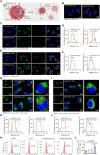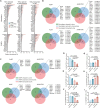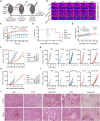Morphology- and adhesion-dual biomimetic nanovaccine boosts antigen cross-presentation through subcellular transport regulation
- PMID: 40737412
- PMCID: PMC12309692
- DOI: 10.1126/sciadv.adx6732
Morphology- and adhesion-dual biomimetic nanovaccine boosts antigen cross-presentation through subcellular transport regulation
Abstract
In situ tumor vaccines have immense potential for immunotherapy because they generate whole tumor-derived antigens (TDAs) to activate antitumor immune responses. However, the rapid degradation and clearance of the released TDAs severely hinder subsequent antigen presentation and the final efficacy of the in situ vaccine. Here, we synthesized gold nanoxanthium coated with polydopamine (AuNX-PDA) to mimic the morphological and biological adhesion properties of xanthium and mussels, respectively. AuNX-PDA facilitated effective absorption of released TDAs after near-infrared II photothermal treatment and delivery of the absorbed TDAs to the endoplasmic reticulum and Golgi apparatus of dendritic cells for cross-presentation, thereby activating CD8+ T cells for efficient tumor-specific immunity. The nanovaccine (NV) significantly inhibited irradiated primary tumors and nonirradiated distant tumors by producing robust antitumor immune responses in B16F10 melanoma and 4T1 breast cancer mouse models. These findings highlight the potency of morphology- and adhesion-dual biomimetic NVs in whole-tumor vaccine therapy.
Figures









Similar articles
-
NIR-II light-driven in situ nanovaccine for cancer immunotherapy via lymph node migration-mediated accumulation.Theranostics. 2025 Jul 2;15(15):7677-7692. doi: 10.7150/thno.114347. eCollection 2025. Theranostics. 2025. PMID: 40756362 Free PMC article.
-
Extracellular vesicles derived from mature dendritic cells loaded with cDC1-specific chemokine XCL1 combined with chemotherapy-induced ICD for the treatment of castration-resistant prostate cancer.Cancer Immunol Immunother. 2025 Jun 18;74(8):242. doi: 10.1007/s00262-025-04070-8. Cancer Immunol Immunother. 2025. PMID: 40531239 Free PMC article.
-
Self-propelled smart nanomotors for enhanced mild photothermal therapy of tumors through autophagy modulation.Acta Biomater. 2025 Jul 1;201:574-590. doi: 10.1016/j.actbio.2025.05.063. Epub 2025 Jun 4. Acta Biomater. 2025. PMID: 40480413
-
In situ antigen-capture strategies for enhancing dendritic cell-mediated anti-tumor immunity.J Control Release. 2025 Sep 10;385:113984. doi: 10.1016/j.jconrel.2025.113984. Epub 2025 Jun 29. J Control Release. 2025. PMID: 40592415 Review.
-
Differentiated strategies for nanovaccines in lymphoma immunotherapy: advances and challenges.J Mater Chem B. 2025 Jul 2;13(26):7609-7636. doi: 10.1039/d5tb00528k. J Mater Chem B. 2025. PMID: 40468788 Review.
References
-
- Long G. V., Swetter S. M., Menzies A. M., Gershenwald J. E., Scolyer R. A., Cutaneous melanoma. Lancet 402, 485–502 (2023). - PubMed
-
- Prokhnevska N., Cardenas M. A., Valanparambil R. M., Sobierajska E., Barwick B. G., Jansen C., Moon A. R., Gregorova P., delBalzo L., Greenwald R., Bilen M. A., Alemozaffar M., Joshi S., Cimmino C., Larsen C., Master V., Sanda M., Kissick H., CD8+ T cell activation in cancer comprises an initial activation phase in lymph nodes followed by effector differentiation within the tumor. Immunity 56, 107–124.e5 (2023). - PMC - PubMed
-
- Liu C., Shi Q., Huang X., Koo S., Kong N., Tao W., mRNA-based cancer therapeutics. Nat. Rev. Cancer 23, 526–543 (2023). - PubMed
-
- Rojas L. A., Sethna Z., Soares K. C., Olcese C., Pang N., Patterson E., Lihm J., Ceglia N., Guasp P., Chu A., Yu R., Chandra A. K., Waters T., Ruan J., Amisaki M., Zebboudj A., Odgerel Z., Payne G., Derhovanessian E., Mueller F., Rhee I., Yadav M., Dobrin A., Sadelain M., Luksza M., Cohen N., Tang L., Basturk O., Goenen M., Katz S., Do R. K., Epstein A. S., Momtaz P., Park W., Sugarman R., Varghese A. M., Won E., Desai A., Wei A. C., D’Angelica M. I., Kingham T. P., Mellman I., Merghoub T., Wolchok J. D., Sahin U., Tuereci O., Greenbaum B. D., Jarnagin W. R., Drebin J., O’Reilly E. M., Balachandran V. P., Personalized RNA neoantigen vaccines stimulate T cells in pancreatic cancer. Nature 618, 144–150 (2023). - PMC - PubMed
MeSH terms
Substances
LinkOut - more resources
Full Text Sources
Research Materials

